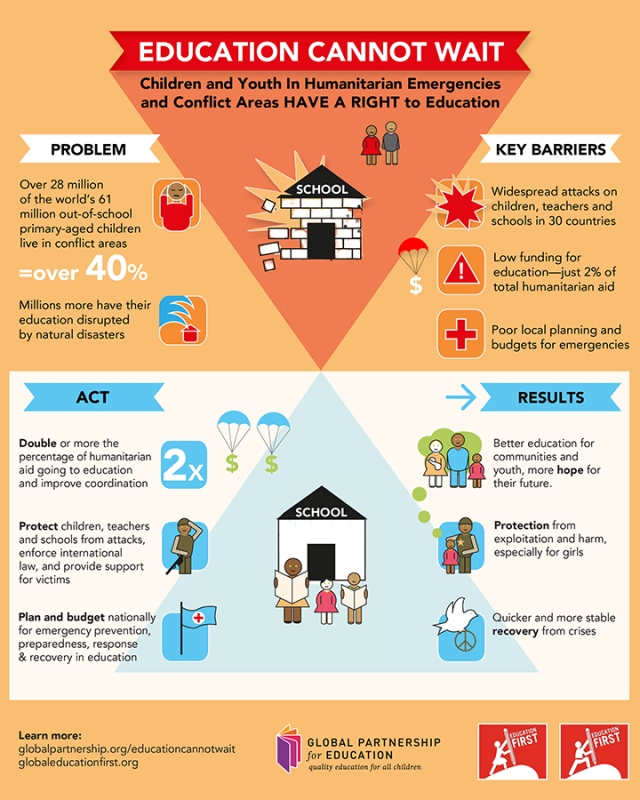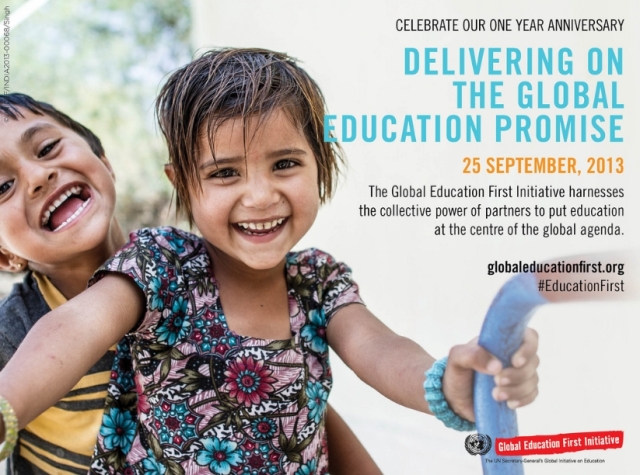
Today, we are celebrating the first-year anniversary of the UN Global Education First initiative launched by UN Secretary General Ban Ki Moon in September 2012. Around the same time last year, over 20 government and global humanitarian, development and education leaders representing Ministries of Education, UN agencies, key funding partners, the private sector and NGOs came together to validate the Education Cannot Wait: Call to Action. They called for urgent action on three fronts to ensure children and youth in situations of conflict and humanitarian emergencies do not forfeit their right to a quality education:
1. Plan for emergency prevention, preparedness and response in education sector plans and budgets;
2. Prioritize education in emergencies by increasing the education share of humanitarian funding from 2% to 4%;
3. Protect children, teachers and education facilities from attacks.
Education in crisis-affected countries: One Year On
Progress has been made against several Call to Action objectives; in conflict- and disaster-sensitive education sector planning, financial support for sector plans in a number of fragile states, new initiatives and/or funding for education in conflict and emergency-affected countries, and high-level advocacy efforts to protect education from attack.
However, despite these positive developments and momentum generated by the Education Cannot Wait Call to Action, the past year shows a sobering reality. New analysis by the Education for All Global Monitoring Report shows that the proportion of primary-aged out-of-school children in conflict-affected countries has increased from 42 percent of the global total in 2008 to 50 percent in 2011. Whereas the global number of children out of school has fallen during this period, the number has gone up in conflict-affected countries; from 28 to 28.5 million. In addition, an estimated 175 million children annually are affected by natural disasters. Marginalized groups, including refugees, internally displaced populations, girls, ethnic minorities and children and youth with disabilities face additional challenges. Of the 28.5 million out of school children in conflict situations, girls make up 55 percent and are the worst affected due to rape and other forms of sexual violence and exploitation.
New high-intensity conflicts, fighting and displacement in countries such as Syria, the Central African Republic, Mali, and in the Democratic Republic of Congo deny children and youth access to education and expose them to grave human rights violations. Millions of others affected by ongoing, protracted conflicts or disasters continue to be at high risk of never going to school, dropping out permanently, or even when in school learning little due to poor education quality. Girls are at increased risk of drop out due to insecurity posed by sexual violence, pregnancy related to rape and other forms of sexual exploitation and abuse including forced marriage.
The danger of attacks at school, and on the way to school, by parties to conflict, further impedes access to education. According to the UN Secretary General’s 2013 report on Children and Armed Conflict, attacks on education, including against schools, students, teachers and other education personnel, are happening in over 17 countries listed by the UN Security Council, with particular concerns for the increase in reports of the use of schools for military purposes in most countries reported upon.
Disturbingly, the share of humanitarian aid to education has continued to decline, despite an increase in humanitarian needs. While aid to education amounted to 2.3 percent of global humanitarian funding in 2010, it was down to only 1.4 percent in 2012. Also, and despite being one of the sectors with the lowest funding requests, education requirements were only 24 percent covered in 2012, leaving a funding gap of USD $221 million. This downward-trend seriously hampers the ability to provide education in emergencies; according to analysis by the Education Cluster, an estimated 13 million beneficiaries—namely children, youth and teachers—could not be reached with education programmes in 2012 due to underfunding of education in humanitarian appeals, including in Consolidated Appeals Process and Flash Appeals.
Education Cannot Wait: Commitment to Action
Ensuring that all children and youth affected by conflicts and the impact of natural hazard have access to safe, quality, relevant education is possible. As personified by Malala, the dreams and ambitions of millions of children and youth for a good education and hope for their future are at stake. Education cannot wait; the future of the world’s children and youth cannot wait.
Children’s and youth’s right to education must be upheld and protected at all times, in situations of conflict or when emergencies strike. Given that 50 per cent of out-of-school children are in conflict situations, and that an estimated 175 million children per year are impacted by situations of natural disaster during the current decade, this is the most important group to target to reach the Millennium Development Goals.
Guided by our fundamental commitment to guarantee that children and youth have access to safe, quality relevant education in all situations, we need to recommit to the Education Cannot Wait Call to Action, and to taking immediate action in order to plan, prioritize and protect education in humanitarian emergencies and conflict situations. We commit to reviewing progress made towards the following commitments at the September 2014 UN General Assembly.

Overall, we commit to ensuring that the post-2015 development agenda includes provision to ensure that all children and youth, regardless of circumstance and particularly those impacted by conflict and crisis, have access to, and learn in safe, quality, relevant education situations.
1. Plan: Integrate emergency prevention, preparedness, response and recovery in education sector plans and budgets
- We commit to ensuring emergency preparedness, response and recovery are integrated into national education sector plans.
- We commit to ensuring that education is included as a central component of governments’ humanitarian policies and funding allocations.
2. Prioritize: Increase levels of humanitarian aid to education and improve its delivery mechanisms
- We commit to increasing humanitarian funding allocations to meet education needs, to contribute towards reaching 4 percent of global humanitarian aid to education.
- We commit to ensuring that education is included in all Humanitarian Action Plans and national strategies to respond holistically to children and youths needs in emergencies.
3. Protect: Keep education safe from attacks
- We commit to ensuring schools remain safe spaces for learning by taking action to stop schools and universities being used for military purposes, including by promoting implementation of the Draft Lucens Guidelines on Protecting Schools and Universities from Military Use during Armed Conflict.
- We commit to increasing support and resourcing to the UN Monitoring and Reporting Mechanism on grave violations against children in situations of armed conflict, including to country task forces, to enhance information gathering, accountability and evidence base to inform advocacy, response and prevention of attacks on schools and school personnel, and military use of schools.
Sources: UN Global Education First & INEE
More information on the 2013 meeting convened to support Secretary-General Ban Ki-moon’s Global Education First Initiative, launched one year ago, and chaired by former British Prime Minister Gordon Brown, UN Special Envoy for Global Education. is available here:
The meeting called for more planning for emergency prevention and integration of emergency preparedness and recovery in education sector plans and national budgets; prioritizing education in emergencies by increasing humanitarian aid to education and improving the way it is delivered on the ground; and protection of children, teachers and education facilities from attacks.
Participants included UNICEF, the UN Educational, Scientific and Cultural Organization (UNESCO), the UN High Commissioner for Refugees (UNHCR) Save the Children, Global Partnership for Education, International Network for Education in Emergencies (INEE), the Global Coalition to Protect Education from Attack, and Plan International.
“Education must be built into peace building – not bolted on – and it must be tied with longer-term development,” UNESCO Director-General Irina Bokova said.
Global Partnership for Education Chief Executive Alice Albright noted that education in emergency situations is severely underfunded, accounting for merely 1.4 per cent of humanitarian aid.
“We should at least double this amount, make it more effective, and improve coordination among Governments, donors and humanitarian agencies,” she said, stressing that quality education requires investment and planning to give children living in some of the toughest parts of the world hope and a chance to shape their futures.
